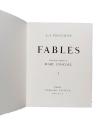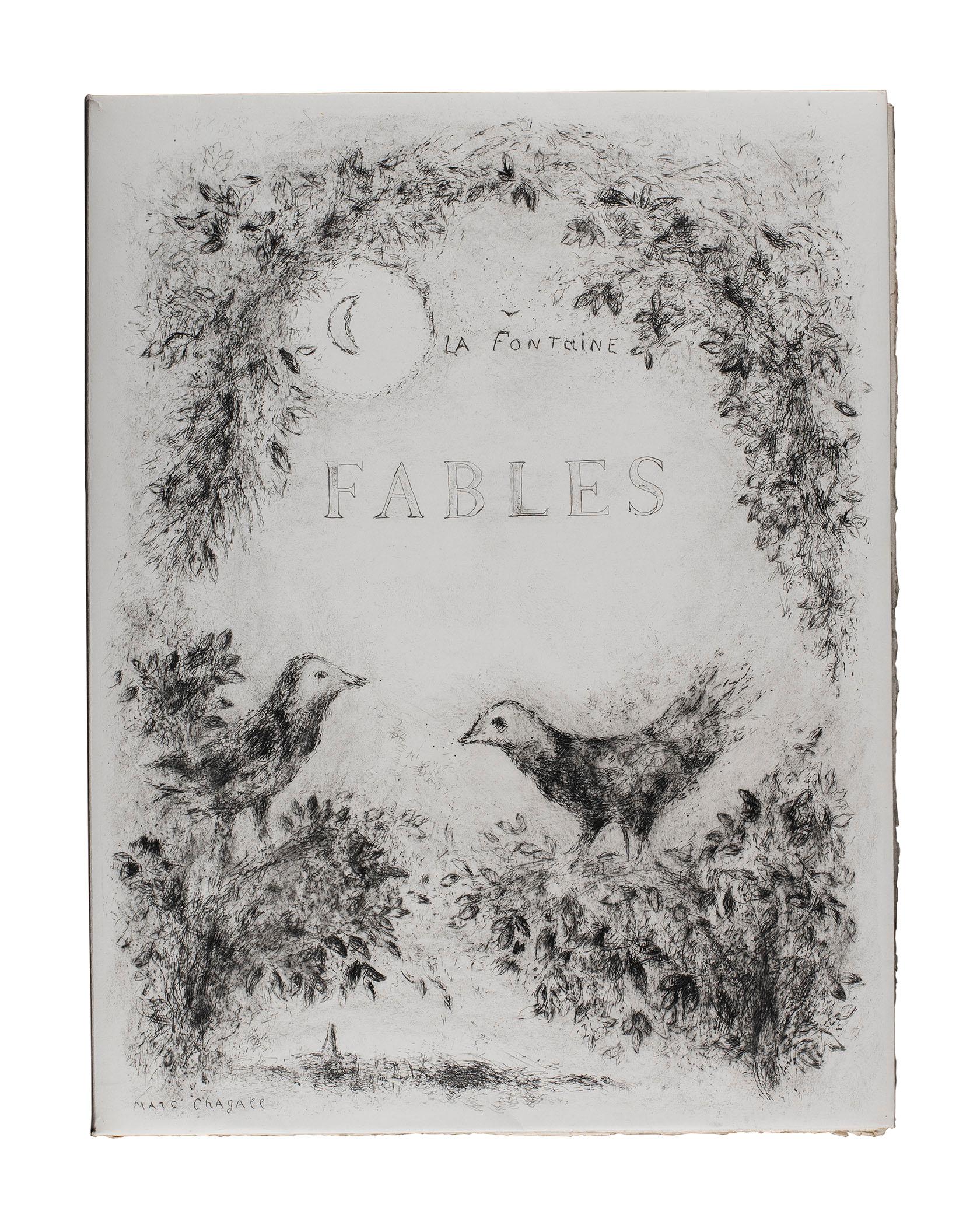
Fables
Artist: Marc Chagall (Russian (active France), 1887-1985)
Author: Jean de La Fontaine (French, 1621-1695)
Publisher: Tériade (Paris, 1952)
Printer: Maurice Potin ([s.l.], 1927-1930)
Printer: Raymond Haasen (1952)
Date: 1952
Dimensions:
Slipcase: H: 16 1/8 in. (410 mm); W: 12 1/2 in. (317 mm); Depth: 1/2 in. (115 mm).
Book: H: 15 5/8 in. (397 mm); W: 12 1/16 in. (307 mm); Depth: 1 15/16 in. (49 mm).
Page (untrimmed): H: 15 7/16 in. (392 mm); W: 11 7/8 in. (302 mm).
Medium: Original drawing: watercolor with black ink (vol. 1).
Original prints: 102 etchings, some with engraving and/or with drypoint, incl. wrappers.
Text: letterpress (typeface: Garamond Italic, 24 pt.).
Paper: Rives BFK cream wove (different stocks, slightly different tones, because the text and etchings were printed 22 years apart).
Classification: Books
Credit Line: Gift of Molly and Walter Bareiss
Object number: 1984.342A-B
Label Text:Two volumes with 100 etchings, two etched covers, and this copy with one watercolor inscribed to "W. Bareiss" and signed by the artist. This was originally commissioned by Vollard in 1927, and initially there was some outcry that a foreign artist had been chosen to illustrate such a venerated French text. The publication, delayed for over twenty years, was finally completed by Teriade.
Marc Chagall, Fables. Text by Jean de La Fontaine (1952)
In 1926, the publisher and art dealer Ambroise Vollard commissioned Marc Chagall to create 100 color images for La Fontaine’s 1668 book of fables. Vollard’s choice of a Russian artist to illustrate these famous French tales was seen as unpatriotic by many Frenchmen. The publisher was forced to explain himself in the newspaper. He pointed out that La Fontaine used many exotic (East Asian) sources for his fables. “Why Chagall?" he concluded. "…Precisely because his aesthetic seems to me very close and in a sense akin to La Fontaine’s, both dense and subtle, realistic and fantastic.”
It proved too difficult to transfer Chagall’s colorful gouache drawings to copper plates. After several attempts, the project was abandoned. A second idea, to use a series of black and white etchings was proposed. Chagall completed the plates, but unfortunately this project too was set aside.
After his international reputation had been firmly established, Chagall regained custody of the plates he had made for Vollard. A new publisher was found, the Greek-born Tériade. Finally, in 1952, a deluxe edition of Chagall’s Fables was completed. Walter Bareiss wisely purchased one of the first copies and Chagall thanked him by inserting an original, signed watercolor drawing inscribed personally to Bareiss.
Marc Chagall, Fables. Text by Jean de La Fontaine (1952)
In 1926, the publisher and art dealer Ambroise Vollard commissioned Marc Chagall to create 100 color images for La Fontaine’s 1668 book of fables. Vollard’s choice of a Russian artist to illustrate these famous French tales was seen as unpatriotic by many Frenchmen. The publisher was forced to explain himself in the newspaper. He pointed out that La Fontaine used many exotic (East Asian) sources for his fables. “Why Chagall?" he concluded. "…Precisely because his aesthetic seems to me very close and in a sense akin to La Fontaine’s, both dense and subtle, realistic and fantastic.”
It proved too difficult to transfer Chagall’s colorful gouache drawings to copper plates. After several attempts, the project was abandoned. A second idea, to use a series of black and white etchings was proposed. Chagall completed the plates, but unfortunately this project too was set aside.
After his international reputation had been firmly established, Chagall regained custody of the plates he had made for Vollard. A new publisher was found, the Greek-born Tériade. Finally, in 1952, a deluxe edition of Chagall’s Fables was completed. Walter Bareiss wisely purchased one of the first copies and Chagall thanked him by inserting an original, signed watercolor drawing inscribed personally to Bareiss.
Not on view
In Collection(s)






















